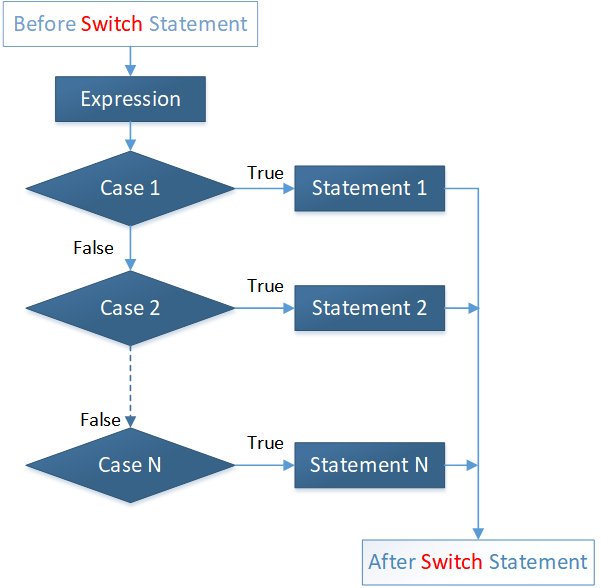JavaScript - Switch
The Switch statement in JavaScript language is used to execute one of many code statements. It can be considered as group of If-else statements.
Syntax
switch (expression){
case 1:
statement 1;
break;
case 2:
statement 2;
break;
...
...
...
case N:
statement N;
break;
default:
default statement;
}
The switch expression is evaluated and matched with the cases. When the case matches, the following block of code is executed.
Flow Diagram:

Example:
In the example below, the switch expression is a variable called day. The getDay() function is used to get the current day as a number. Based on the value of the day variable, the program prints the current day.
var day = new Date().getDay();
var txt;
switch(day) {
case 0:
txt = "Sunday";
break;
case 1:
txt = "Monday";
break;
case 2:
txt = "Tuesday";
break;
case 3:
txt = "Wednesday";
break;
case 4:
txt = "Thursday";
break;
case 5:
txt = "Friday";
break;
case 6:
txt = "Saturday";
}
txt = "Today is " + txt + ".";
The output (value of txt) after running above script will be:
default and break statements
Default case and break statement are optional here.
- Default Case: Default Statement is executed when there is no match between switch expression and test cases.
- Break Statement: Break statement is used to get out of the Switch statement after a match is found.
Example:
In the example below, default statement is used. The default code block is executed, whenever the value of switch expression day is not equal to 0 or 6.
var day = new Date().getDay();
var txt;
switch(day) {
case 0:
txt = "Today is Sunday.";
break;
case 6:
txt = "Today is Saturday.";
break;
default:
txt = "Today is not a weekend.";
}
The output of the above code will be:
Please note that, the default statement can be placed at any position in the switch statement. In such instances, add break statement with default statement.
Example:
Consider the example below, where default statement is placed on the top in a switch statement.
var day = new Date().getDay();
var txt;
switch(day) {
default:
txt = "Today is not a weekend.";
break;
case 0:
txt = "Today is Sunday.";
break;
case 6:
txt = "Today is Saturday.";
}
The output of the above code will be:
Common code blocks
There are instances where same code block is required in multiple cases.
Example:
In the example below, same code block is shared for different switch cases.
var day = new Date().getDay();
var txt;
switch(day) {
case 1:
case 2:
case 3:
case 4:
case 5:
txt = "Today is a weekday.";
break;
case 0:
case 6:
txt = "Today is a weekend.";
}
The output of the above code will be:


